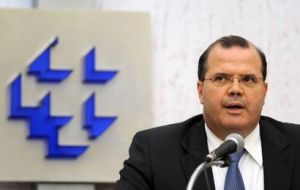MercoPress. South Atlantic News Agency
Brazil hikes basic rate to 12.25% and further increases can be expected
 Bank president AlexandreTombini: the gradual adjustment approach in unanimous
Bank president AlexandreTombini: the gradual adjustment approach in unanimous Brazil's central bank increased late Wednesday its benchmark interest rate for the fourth straight meeting after consumer prices exceeded the upper limit of its target range for the first time since 2005.
Brazil’s central bank hiked the benchmark lending rate for a fourth straight time and signaled it is prepared to increase borrowing costs further, after consumer prices exceeded the upper limit of its target range for the first time since 2005.
Policy makers, led by central bank President Alexandre Tombini, raised the Selic rate by a quarter points to 12.25%.
Annual inflation in the world's seventh-largest economy rose to 6.51%, above the top of the bank's target range, in April and accelerated to 6.55% in May. Policy makers in April said that a “sufficiently prolonged” series of rate increases, government spending cuts and curbs on credit will ease prices back to target in 2012
“Giving continuity to the process of gradual adjustment of monetary conditions, the monetary policy committee decided unanimously to raise the Selic rate to 12.25% a year, without a bias.
“Taking into account the balance of inflation risks, the still uncertain rhythm of the moderation of domestic activity, as well as the complexity of the international environment, the committee understands that, at the moment, the implementation of adjustment in monetary conditions for a sufficiently long period continues to be the most adequate strategy to ensure the convergence of inflation to the target in 2012”.
Traders expect at least one more quarter-point increase in 2011. The central bank targets inflation of 4.5%, plus or minus two percentage points. But other factors are also influencing inflation.
Unemployment fell in April to the lowest level on record for the month, keeping pressure on policy makers trying to cool the economy.
In its most recent quarterly inflation report, the central bank said moderation in wage increases is ”a key element for obtaining a macroeconomic environment with price stability.” Carlos Hamilton, the central bank's director for economic policy, said May 19 that employment is at its highest level in decades.
The Brazilian economy gained speed in the first quarter. GDP expanded 1.3% from the previous three- month period. In the fourth quarter of 2010, GDP grew 0.8%. Total outstanding credit rose 21% from a year earlier in April.
But each rate increase to help contain inflation adds to what is already one of the world’s highest real interest rates – the root cause of rapid capital inflows and the upward pressure on the exchange rate. This is eroding the competitiveness of the manufacturing sector and giving growth a rather unbalanced look.
Other central banks in the region are also tightening policy. Chile raised its benchmark interest rate for the 11th time in 12 months in May. Peru raised borrowing costs to the highest level in two years last month and Colombia raised its benchmark interest rate for a fourth straight meeting on May 30.




Top Comments
Disclaimer & comment rulesCommenting for this story is now closed.
If you have a Facebook account, become a fan and comment on our Facebook Page!